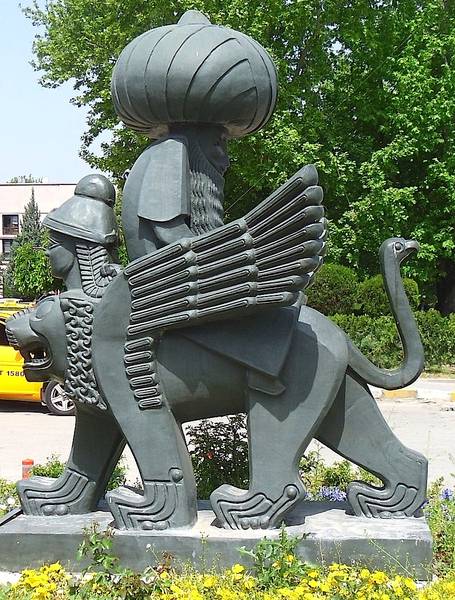Nasreddin Hoca is the darling of the souvenir shops. More or less all over Turkey one can find the figure of the rotund sage with his outsize turban and huge prayer beads, on books, statues and statuettes and a variety of objects. His philosophy, with its touch of the absurd and at the same time faultless, infuriating logic, is alive and kicking—so much so that to this day new Nasreddin objects are invented to supply a market that is clearly thriving. The last on the list is a clock that goes backwards while still telling the time correctly. Nasreddin himself was fond of playing with the subjective idea of direction. He would not be faulted for riding backwards on his donkey since, according to him, it was the animal that was facing the wrong way. And so the legend grows and grows. Generation of children have been brought up on his moralising tales while the saucier stories feature in adult conversations with innuendoes that all, at least all Turks, can follow.

The man himself is a bit of a mystery. It is not even sure that he ever existed. Experts have pored over all the stories that are attributed to him and agree that he must have lived somewhere between the 13th and 15th centuries. Tamerlane, the man from the east who plunged Anatolia into chaos towards the end of the 14th century, features in one of his tales. The general consensus is that Nasreddin is the expression of the popular wisdom of the Anatolian peasant caught up in the conflicts between embattled Byzantines, insurgent Turks and conquering Mongols. The battlefield was always the same: Anatolia. Its peasants bore the brunt of the havoc created by the clashing armies. Humour was one answer, possibly the only one available. Today the Byzantines are no more, the insurgent Turks have been tamed and the Mongols have gone back home. The Anatolian peasant is still there.
Over time the legendary Hoca has been given some flesh and bones. The Ottomans started the ball rolling in 1905 when a kiosk was built enclose the so-called tomb of the sage in Akşehir. The town developed as a Nasreddin destination complete with a ‘centre of the world monument’ and more recently a park containing lifesize images of his stories, including a gigantic cauldron that featured in ‘The Cauldron that Died’. The giant trestle enabling tourists to be photographed wearing the Hoca’s trademark outsize turban is unfortunately no more. Akşehir, a town otherwise of little interest, did well by the tourist trade until a nearby rival, Sivrihisar, entered the scene. There is nothing to link Sivrihisar to Nasreddin Hoca (at least nothing that can be historically proven) and the same applies to Akşehir. Yet now they claim to have a tomb with his and his daughter’s bones, proof positive that he was born there when the town was called Hortu, as well as his house, still standing 800 years on (quite a feat for a wood and mudbrick structure).
Recently yet another contender has thrown its hat into the arena, giving the Hoca’s story a complete new twist. In Ankara, as you leave the railway station, you are welcomed by a statue. There is something uncannily familiar about it. The huge turban, the backwards riding position: we have seen this before. But Nasreddin is not on a donkey. Instead he is riding a Zincirli neo-Hittite lion, genetically twinned with a sphinx, hence the wings. The tail is that of a snake. Suddenly the sage has been pushed back a couple of thousand years, if not more. The sphinx is an Egyptian connection and harks back to the Hittites who had close contacts with them. Those were the good old days, when the king of the Hittites could look the pharoah in the eye, call him ‘my brother’ and give him his daughter in marriage. Suddenly the Turkish presence in Anatolia lays claim to stretch back that far, though historically it is known that Turkish tribes began infiltrating the Byzantine Empire from the East in the early 11th century. It is entirely appropriate that this pastiche of a monument should be in Ankara, the city from which Atatürk made his bid to supply the emerging Turkish nation with a glorious past dating back to the dawn of time. He was not interested in a merely Islamic past. Instead he bent the archaeology and the historical evidence to his aims—and although recently Ankara has somewhat reneged on this legacy, as the disagreements over the city’s emblem show, the rejection of it is clearly not one hundred percent.
by Paola Pugsley. Paola is the author of three ebooks on Turkey, published by Blue Guides. Her Central Anatolia with Cappadocia is currently in preparation.






